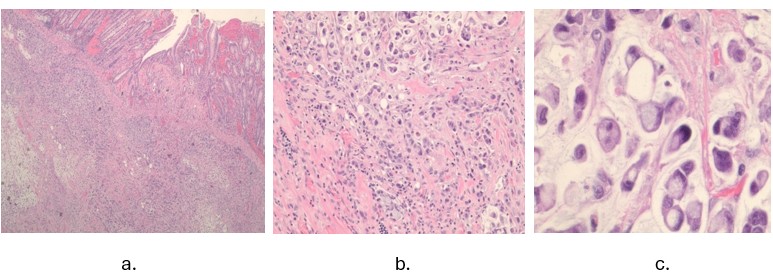Tuesday Poster Session
Category: Colon
P4615 - Incidental Signet-Ringed Colorectal Cancer in a Young Male With Thromboembolic Comorbidities: A Diagnostic Challenge
Tuesday, October 28, 2025
10:30 AM - 4:00 PM PDT
Location: Exhibit Hall
- BK
Bibek Karki, MD, MPH
Hurley Medical Center/Michigan State University
Grand Blanc, MI
Presenting Author(s)
Hoyam Elhaj Omer, MD1, Samjhana Belbase, MD2, Bibek Karki, MD, MPH2
1Hurley Medical Center/Michigan State University, Flint, MI; 2Hurley Medical Center/Michigan State University, Grand Blanc, MI
Introduction: Signet-ring colorectal cancer is a rare, aggressive form of colorectal cancer, often diagnosed at an advanced stage. It has a poor prognosis with a mean survival of 20-45 months. Unprovoked Venous thromboembolism (VTE) in young patients warrants evaluation for an underlying occult malignancy.
Case Description/
Methods: We report the case of a 35-year-old male with a history of hypertension, tobacco and alcohol use, who presented with right lower extremity pain and shortness of breath. Physical examination revealed bilateral lower extremity edema, calf tenderness, and bibasilar crackles. Patient denied trauma or prolonged immobilization. No personal or family history of clotting disorder, recurrent DVT/PE, or malignancy. Initial imaging demonstrated extensive deep vein thrombosis (DVT) involving the femoral, popliteal, peroneal, and posterior tibial veins. CT angiography revealed bilateral pulmonary emboli with signs of right heart strain. The patient was started on intravenous heparin and underwent catheter-directed thrombolysis (EKOS). Given his age and extensive thromboembolic burden, a malignancy workup was initiated. Abdominal CT imaging revealed focal mural thickening of the ascending colon and adjacent mesenteric lymphadenopathy, raising suspicion for a neoplastic process. During hospitalization, the patient developed intestinal obstruction requiring exploratory laparotomy. Intraoperative findings included a hepatic flexure mass and palpable mesenteric lymphadenopathy. Right hemicolectomy was performed, and histopathology confirmed poorly differentiated signet ring cell carcinoma with lymph node metastases. The patient was discharged after his condition stabilized, with a follow-up plan with the oncologist, including a PET scan for staging and pursuing a further management plan.
Discussion: This case highlights the importance of considering occult malignancy in young patients presenting with unprovoked or extensive VTE. Colonic signet ring cell carcinoma, though rare, can initially manifest through thromboembolic events. Early recognition and comprehensive evaluation with a multidisciplinary approach are essential for timely diagnosis and management.

Figure: Figure: Histopathological slides showing signet ring cells with intracellular mucin displacing nucleus to periphery in a. low resolution (2x), b. medium power (10x), and c. high power (40x)
Disclosures:
Hoyam Elhaj Omer indicated no relevant financial relationships.
Samjhana Belbase indicated no relevant financial relationships.
Bibek Karki indicated no relevant financial relationships.
Hoyam Elhaj Omer, MD1, Samjhana Belbase, MD2, Bibek Karki, MD, MPH2. P4615 - Incidental Signet-Ringed Colorectal Cancer in a Young Male With Thromboembolic Comorbidities: A Diagnostic Challenge, ACG 2025 Annual Scientific Meeting Abstracts. Phoenix, AZ: American College of Gastroenterology.
1Hurley Medical Center/Michigan State University, Flint, MI; 2Hurley Medical Center/Michigan State University, Grand Blanc, MI
Introduction: Signet-ring colorectal cancer is a rare, aggressive form of colorectal cancer, often diagnosed at an advanced stage. It has a poor prognosis with a mean survival of 20-45 months. Unprovoked Venous thromboembolism (VTE) in young patients warrants evaluation for an underlying occult malignancy.
Case Description/
Methods: We report the case of a 35-year-old male with a history of hypertension, tobacco and alcohol use, who presented with right lower extremity pain and shortness of breath. Physical examination revealed bilateral lower extremity edema, calf tenderness, and bibasilar crackles. Patient denied trauma or prolonged immobilization. No personal or family history of clotting disorder, recurrent DVT/PE, or malignancy. Initial imaging demonstrated extensive deep vein thrombosis (DVT) involving the femoral, popliteal, peroneal, and posterior tibial veins. CT angiography revealed bilateral pulmonary emboli with signs of right heart strain. The patient was started on intravenous heparin and underwent catheter-directed thrombolysis (EKOS). Given his age and extensive thromboembolic burden, a malignancy workup was initiated. Abdominal CT imaging revealed focal mural thickening of the ascending colon and adjacent mesenteric lymphadenopathy, raising suspicion for a neoplastic process. During hospitalization, the patient developed intestinal obstruction requiring exploratory laparotomy. Intraoperative findings included a hepatic flexure mass and palpable mesenteric lymphadenopathy. Right hemicolectomy was performed, and histopathology confirmed poorly differentiated signet ring cell carcinoma with lymph node metastases. The patient was discharged after his condition stabilized, with a follow-up plan with the oncologist, including a PET scan for staging and pursuing a further management plan.
Discussion: This case highlights the importance of considering occult malignancy in young patients presenting with unprovoked or extensive VTE. Colonic signet ring cell carcinoma, though rare, can initially manifest through thromboembolic events. Early recognition and comprehensive evaluation with a multidisciplinary approach are essential for timely diagnosis and management.

Figure: Figure: Histopathological slides showing signet ring cells with intracellular mucin displacing nucleus to periphery in a. low resolution (2x), b. medium power (10x), and c. high power (40x)
Disclosures:
Hoyam Elhaj Omer indicated no relevant financial relationships.
Samjhana Belbase indicated no relevant financial relationships.
Bibek Karki indicated no relevant financial relationships.
Hoyam Elhaj Omer, MD1, Samjhana Belbase, MD2, Bibek Karki, MD, MPH2. P4615 - Incidental Signet-Ringed Colorectal Cancer in a Young Male With Thromboembolic Comorbidities: A Diagnostic Challenge, ACG 2025 Annual Scientific Meeting Abstracts. Phoenix, AZ: American College of Gastroenterology.
